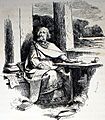Ulfilas facts for kids
Quick facts for kids
Ulfilas
Gothic: Wulfila
|
|
 Wulfila explaining the Gospels to the Goths |
|
| Born | c. 311 in |
|---|---|
| Died | 383 in |
| Writings | oversaw the translation of the Bible into Gothic |
| Offices held | Bishop of the Goths |
| Children | (adopted) Auxentius of Durostorum |
Ulfilas (around 311–383) was a very important person for the Goths, an ancient people. His name, Ulfilas, is a Latin way of saying his Gothic name, Wulfila. This name means "Little Wolf."
Ulfilas was a bishop, which is a leader in the Christian church. He was also a missionary, meaning he traveled to teach people about Christianity. He is most famous for helping to translate the Bible into the Gothic language. To do this, he even created the Gothic alphabet, a special way of writing for the Gothic language. While people often say Ulfilas did it all himself, experts think he led a team of translators.
Contents
Ulfilas's Life Story
Ulfilas's parents were not Goths. They were from a place called Cappadocia, which is in modern-day Turkey. Around the year 264, Gothic raiders captured his parents from their village. They were taken to live in lands north of the Danube River, where the Goths lived.
Ulfilas grew up among the Goths and learned their ways. He also became very good at speaking Greek and Latin. He became a Christian and taught many Goths about his faith. He followed a certain type of Christianity called Arianism. This was different from the main Christian beliefs in the Roman Empire at the time.
In 341, Ulfilas became a bishop. He worked as a missionary for seven years. But in 348, he had to leave the Gothic lands. A Gothic leader, probably Athanaric, was persecuting Christians. Ulfilas and his followers moved to a new area called Moesia, which was part of the Roman Empire. This was near modern-day Bulgaria.
It was in Moesia that Ulfilas created the Gothic alphabet. This new writing system was based on the Greek alphabet. He then led a group of people in translating the Bible from Greek into the Gothic language. Parts of this Gothic Bible still exist today, like the famous Codex Argenteus (Silver Book), which is kept in Sweden.
How We Know About Ulfilas
We learn about Ulfilas from old writings. There are five main sources that tell us about his life. Some of these writings were by people who shared Ulfilas's Arian beliefs. Others were by people who followed the main Christian beliefs of the Roman Empire.
These different accounts tell slightly different stories. For example, the Arian writings say Ulfilas was an Arian Christian from a young age. They say he became a bishop around 340 and taught the Goths for seven years. Then he moved to Moesia under the protection of the Arian Roman Emperor.
The other writings say Ulfilas was a mainstream Christian for most of his early life. They claim he became an Arian later, around 360, because of political pressure. These writings also differ on how much credit Ulfilas should get for converting the Goths.
Today, many experts trust the Arian accounts more. This is because the people who wrote them were closer to Ulfilas and likely had more accurate information.
Ulfilas's Beliefs
Ulfilas had a clear statement of his beliefs, called a "creed." This creed was written down by his adopted son and student, Auxentius. In this statement, Ulfilas explained his understanding of God the Father, God the Son (Jesus Christ), and the Holy Spirit.
He believed in "one God the Father," who was "unbegotten" (meaning not created). He also believed in "his only-begotten son, our Lord and God," who created everything. And he believed in "one Holy Spirit," which gives light and makes things holy. He saw the Son and the Holy Spirit as working with and being obedient to God the Father.
Honors for Ulfilas
- Wulfila Glacier on Greenwich Island in Antarctica is named after Bishop Ulfilas.
- A part of the Walhalla (memorial) in Bavaria, Germany, honors him.
See also
 In Spanish: Ulfilas para niños
In Spanish: Ulfilas para niños
- Gothic Bible
- Gothic Christianity
Images for kids




